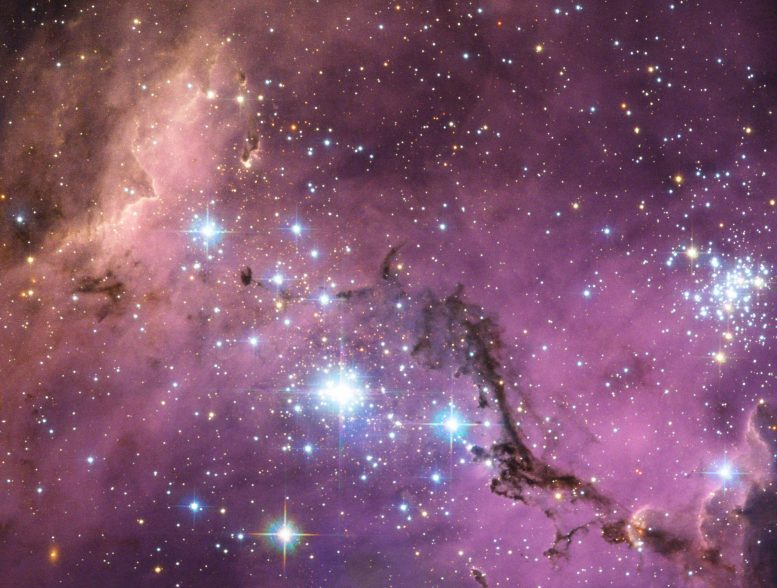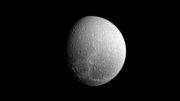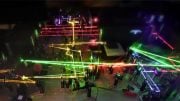
Nearly 200 000 light-years from Earth, the Large Magellanic Cloud, a satellite galaxy of the Milky Way, floats in space, in a long and slow dance around our galaxy. As the Milky Way’s gravity gently tugs on its neighbor’s gas clouds, they collapse to form new stars. In turn, these light up the gas clouds in a kaleidoscope of colors, visible in this image from the NASA/ESA Hubble Space Telescope. Credit: NASA, ESA, Acknowledgment: Josh Lake
This Hubble Space Telescope image shows the Large Magellanic Cloud and the many star-forming regions within it.
Nearly 200,000 light-years from Earth, the Large Magellanic Cloud, a satellite galaxy of the Milky Way, floats in space, in a long and slow dance around our galaxy. Vast clouds of gas within it slowly collapse to form new stars. In turn, these light up the gas clouds in a riot of colors, visible in this image from the NASA/ESA Hubble Space Telescope.
The Large Magellanic Cloud (LMC) is ablaze with star-forming regions. From the Tarantula Nebula, the brightest stellar nursery in our cosmic neighborhood, to LHA 120-N 11, part of which is featured in this Hubble image, the small and irregular galaxy is scattered with glowing nebulae, the most noticeable sign that new stars are being born.
The LMC is in an ideal position for astronomers to study the phenomena surrounding star formation. It lies in a fortuitous location in the sky, far enough from the plane of the Milky Way that it is neither outshone by too many nearby stars, nor obscured by the dust in the Milky Way’s center. It is also close enough to study in detail (less than a tenth of the distance of the Andromeda Galaxy, the closest spiral galaxy), and lies almost face-on to us,[1] giving us a bird’s eye view.
Pan across LHA 120-N11
LHA 120-N 11 (known as N11 for short) is a particularly bright region of the LMC, consisting of several adjacent pockets of gas and star formation. NGC 1769 (in the center of this image) and NGC 1763 (to the right, see heic1011) are among the brightest parts.
In the center of this image, a dark finger of dust blots out much of the light. While nebulae are mostly made of hydrogen, the simplest and most plentiful element in the Universe, dust clouds are home to heavier and more complex elements, which go on to form rocky planets like the Earth. Much finer than household dust (it is more like smoke), this interstellar dust consists of material expelled from previous generations of stars as they died.
Zoom into LHA 120-N11
The data in this image were identified by Josh Lake, an astronomy teacher at Pomfret School in Connecticut, USA, in the Hubble’s Hidden Treasures image processing competition. The competition invited members of the public to dig out unreleased scientific data from Hubble’s vast archive, and to process them into stunning images.
Josh Lake won first prize in the competition with an image contrasting the light from glowing hydrogen and nitrogen in N11. The image above combines the data he identified with additional exposures taken in blue, green and near infrared light.
Notes
- Although the Large Magellanic Cloud is generally classified as an irregular galaxy, it shares some features with spiral galaxies, including a clearly visible bar, and a single spiral-arm-like structure. It is thought that the LMC may be a small spiral galaxy that was pulled out of shape by the Milky Way.
The Hubble Space Telescope is a project of international cooperation between ESA and NASA.









A fantastic spectacle indeed from Hubble Telescope. Our Milky Way Galaxy is about 100,000 light years in diameter. If our neighbor at just a distance of 200,000 light years from earth is photographed in detail, it is a grand sight. We called our neighbors as Large Magellanic Cloud and Small Magellanic Cloud and also another nearby galaxy Andromeda which are all in nebulous form containing largely clouds of dusts and stars in formation. Moreover their celestial dances of orbiting one another as this Large Magellanic cloud circling around our Milky Way Galaxy signifies Galactic cannibalism of one eating the other in the long run. Thank You.